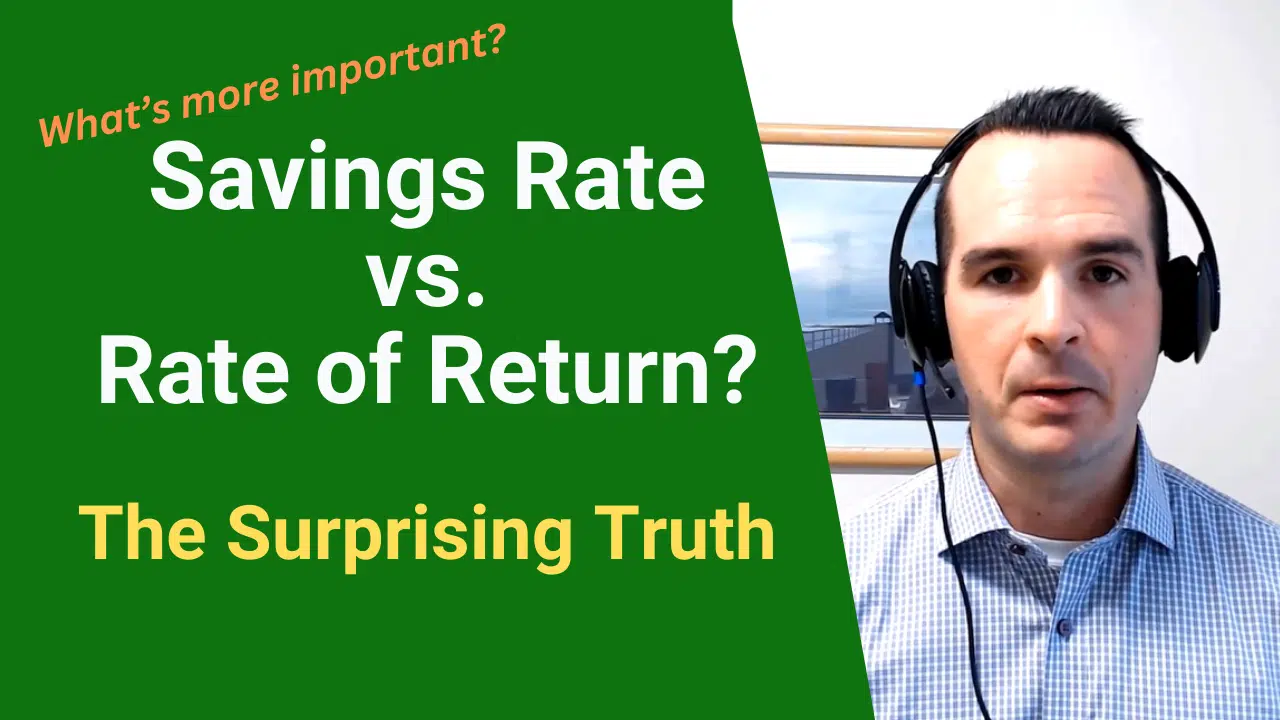Savings Rate vs Rate of Return
Key takeaways:
- Why savings rate matters more when choosing between savings rate vs rate of return
- How compound interest and contributions work together over decades
- Why you shouldn’t count on your investments to “bail you out” if you under-save or overspend
- The importance of a balanced approach in retirement planning
- The difference between focusing on your savings rate during accumulation vs. your spending rate in retirement
Savings Rate vs Rate of Return – Links
Catch all our Mullooly Asset videos here
Subscribe to the Mullooly Asset YouTube Channel
Watch this episode (“Savings Rate vs Rate of Return?”) on our YouTube Channel
Link to Brendan’s original post: The Heavy Lifting
Savings Rate vs Rate of Return – Transcript
“Savings Rate vs Rate of Return on your investments.”
Which one is more important?
This is going to be a throwback to a post Brendan did after one of our annual canoe trips up to upstate New York.
Brendan had an epiphany that the river was actually doing most of the work. So he wrote about, and applied that to the investing landscape.
And, which is more important, “saving money over time”…or “your rate of return over time?”
Or, savings rate vs rate of return?
He tried to answer the question “can your investments ‘out-earn’ a lack of savings?”
You know, maybe the thought process is if you throw some money into an investment account, you hit it big; you make a ton of money…
Can that can make up for, you don’t have to save as much, over time?
Maybe that happens. But the odds of it happening are pretty small.
Really, what we’re all about here are stacking the odds of success in your favor.
And the way to do that.. the way that Brendan wrote about, and I’m going to show you here… is to really focus on your savings rate vs rate of return.
And not so much about your rate of return.
Brendan made a chart, where he looked at different rates of return, on the left.
These are annualized rates of return on the left.
And then amounts saved across the bottom.
And that ending balance over 20 years.
So on the bottom left, you can see a 4% rate of return with $3,600 saved annually.
Leaves you with about $107,200 after 20 years.
Going to the other side of the chart. An annual savings amount of $18,000 and an 8% annualized return over 20 years, leaves you with $823,715.
So, let’s say your goal is to get to $500,000 saved.
You can do that a couple different ways.
If you save $10,800 per year, AND you earn 8% per year, that gets you pretty close to $500,000.
Or… if you save $18,000 per year… you don’t even have to earn 4%, in order to get that 500,000.
A couple of different ways to get there.
Obviously, the one thing that you CAN control is your savings rate.
You want to make sure that you know you have control over that.
You want to make sure that you’re maximizing those dollars.
I know in the beginning, especially, it’s hard to see your contributions, and it is hard to see that compound interest.
But over 20, 30, 40 year time horizon, that compounding… and those contributions… are going to do “the heavy lifting” for you.
Until you get to a certain point. And then the compound interest in your investment really starts to kick in and, you hopefully see some pretty big gains in your account.
The same concept applies to a different question that a lot of retirees face.
Maybe they want to spend more than what is recommended from their portfolio each year.
And, they might think, “well, won’t the investments make up for it? We’ve done really well the last couple years!”
Won’t the investments make up for it?
And it’s like, “you know, I never took the money out in the first place!”
Maybe that’s the case, but again, it’s about stacking the odds in your favor.
You especially don’t want to “ratchet up the risk” in retirement and try to “hit a home run” on some investment, to make up for it — and for what you’re spending from the account.
We want to take a more balanced approach.
Especially if you’re taking money out in retirement. You know, obviously we want to, the whole goal of saving the money and working with a financial planner is to outline the best way for you to live “the life you want!”
And to enjoy the money that you worked for, and saved over time.
But we want to make sure that they’re doing that with “eyes wide open,” and knowing the different levers that we can pull… if things need to be adjusted.
So, the same bears true… whether you’re early on and, and accumulating. Or whether you’re in the decumulating retirement phase of life.
(When it comes to savings rate vs rate of return,) early on, you want to worry about your savings rate.
Later on, you want to worry about your spending rate.
And banking on your investments to “bail you out” of either of those things…I don’t know if that’s such a good idea.
So thanks, Brendan for the inspiration for this video.
We’ll link up to the original blog post so you can check it out.
I think there was a picture from the canoe trip in there.
So, we’ll link that up and thanks, as always, for watching “savings rate vs rate of return.”
We’ll be back with you on the next one.







